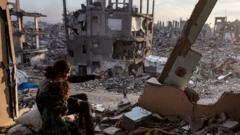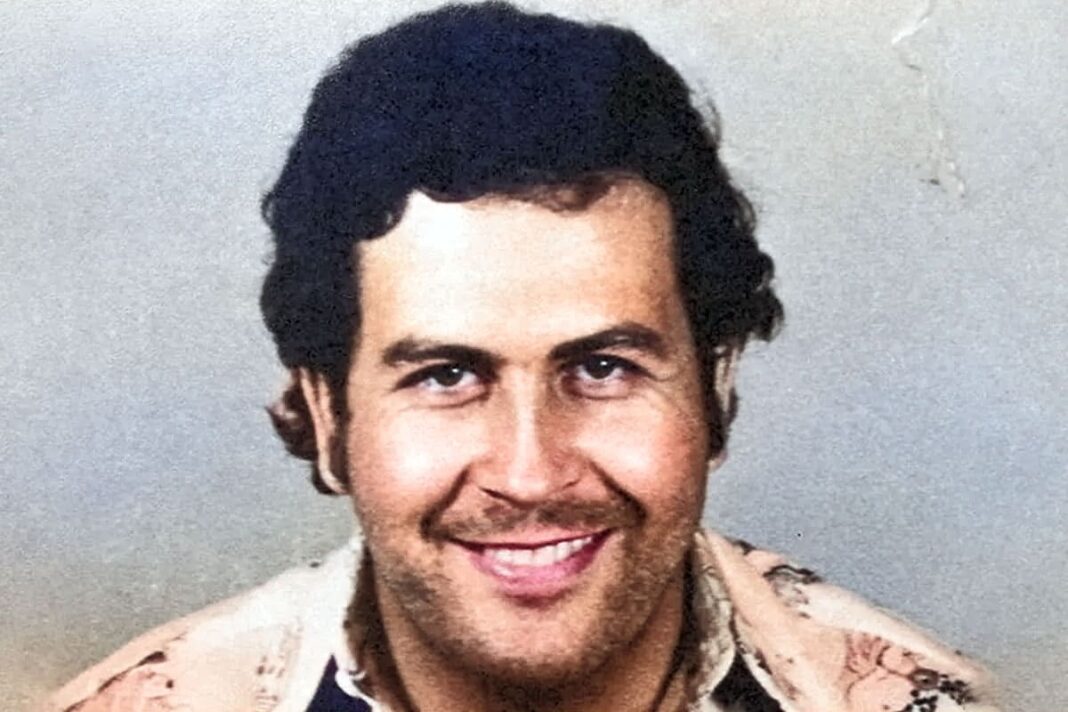Yolande Knell
Middle East correspondent
Reporting fromJerusalem
Rushdi Abualouf
Gaza correspondent
Reporting fromCairo
EPA
Many displaced Palestinians have returned to the ruins of their homes in the north
The Gaza ceasefire deal between Israel and Hamas has looked shaky since it came into force on 19 January but now looks the closest yet to totally falling apart.
A senior Egyptian source told the BBC that regional mediators Egypt and Qatar were “intensifying their diplomatic efforts in an attempt to salvage the ceasefire agreement”.
A top-level Hamas delegation has now arrived in Cairo for talks “to contain the current crisis”, a Hamas official told the BBC. He reiterated his group’s “full commitment” to the terms of the deal.
On Tuesday, Israel’s Prime Minister Benjamin Netanyahu said: “If Hamas does not return our hostages by Saturday noon, the ceasefire will end and the [Israeli military] will resume intense fighting.”
Reuters
The Israeli military said it was sending reinforcements to southern Israel on Tuesday
However, there has been mixed messaging on whether he means all 76 hostages still in Gaza – in line with the high-stakes ultimatum recommended by US President Donald Trump.
Trump was reacting to a Hamas threat to derail the agreement on Monday.
It complained of Israeli ceasefire violations, in particular relating to aid, and warned that it would delay the release of hostages on Saturday.
In the past week, the president’s new radical plan for a US takeover of Gaza – without its two million Palestinian residents – has also changed the context for the ceasefire which his administration helped to broker.
On Wednesday, the White House restated Trump’s plan, while admitting that Jordan’s King Abdullah II had rejected the idea during talks in Washington a day earlier.
“The king would much prefer that the Palestinians stay in place,” White House press secretary Karoline Leavitt said. “But the president feels it would be much better and more majestic if these Palestinians could be moved to safer areas.”
‘We are tired of war’: Israelis and Gazans fear ceasefire collapseEgypt to present ‘vision’ to rebuild Gaza without displacementWhy does Trump want to take over Gaza and could he do it?So, what more do we know about what has been happening behind the scenes?
When it comes to the outcome of the four-hour Israeli security cabinet meeting on Tuesday, Israeli journalists admitted puzzlement over contradictory and confusing briefings.
After the Israeli prime minister’s video message demanded the release of “our” hostages, the first reports – quoting an unnamed senior Israeli official – said this referred to the original three male hostages scheduled to be freed.
It was then said that Israel expected the final nine living hostages slated for release in the six-week first phase of the ceasefire to be freed, which is supposed to see a total of 33 captives handed over.
Key ministers then began to weigh in. Miri Regev – a close ally of Netanyahu – said on X the decision was “very clear” and echoed the Trump demand. She said: “By Saturday, everyone will be released!”
The far-right Israeli finance minister Bezalel Smotrich – who has threatened to leave Netanyahu’s coalition if there is not a return to fighting at the end of the six-week ceasefire deal – went further still.
On social media, he proposed telling Hamas to release all the hostages or else have “the gates of hell” opened, with no fuel, water or humanitarian aid entering Gaza.
He said there should be “only fire and brimstone” from Israeli warplanes and tanks, with the strip completely occupied and its population expelled.
“We have all the international backing for this matter,” he stated.
His comments indicate how Trump’s post-war vision for Gaza has strengthened the far-right in Israel.
That is said to worry the Israeli security chiefs who negotiated the current ceasefire deal and believe its collapse will endanger hostages’ lives.
Israeli media report that they are pushing for a way to bring back the next three captives held by Hamas on schedule at the weekend.
Hostages’ families and their supporters have been alarmed by the latest developments, as have war-weary Gazans.
Reuters
The hostages’ families are urging the Israeli government to ensure all of them are released
The fact that the Hamas leader for Gaza, Khalil al-Hayya, is leading a delegation to follow up on implementation in Cairo, shows that the armed group is also trying to get the ceasefire agreement back on track.
Since 19 January, the deal has seen a total of 16 Israeli hostages brought home in exchange for hundreds of Palestinian prisoners held by Israel. Five Thai farm workers were also released.
At the same time, Israeli troops have withdrawn to just inside the perimeter of Gaza, including along the Egypt border.
The relative calm has allowed hundreds of thousands of displaced Palestinians to return to their own neighbourhoods and brought in a surge of humanitarian aid.
However, the current impasse stems from Hamas’s claim that Israel has not upheld its promises for the first phase of the truce.
It says that this required Israeli authorities to allow about 300,000 tents and 60,000 caravans into Gaza.
With so many people returning to the ruins of their homes – during cold, wet wintry weather – such shelters have been desperately needed.
Fuel and generators are also said to be in short supply – especially in the north of Gaza – where they are urgently required, especially for water pumps and bakeries.
It is hard to verify exactly what has gone into the strip.
According to figures quoted by the UN, “since the ceasefire came into effect, 644,000 people across Gaza have received shelter assistance including tents, sealing-off materials and tarpaulins”.
The Israeli military body Cogat said that Israel was “committed to and is fulfilling its obligation to facilitate the entry of 600 humanitarian aid trucks into the Gaza Strip each day”.
It added: “According to the data available to us, since the agreement came into effect, hundreds of thousands of tents have entered the Gaza Strip.”
EPA
Palestinians have been allowed to travel through the Israeli military’s Netzarim Corridor that divided Gaza in two
Despite the conflicting accounts, it can be assumed that issues over aid that Israel allows into Gaza could be resolved by mediators.
“Cairo and Doha are urging all parties to adhere to the terms of the agreement amid political and field complexities that make the task more challenging,” the senior Egyptian source told the BBC.
“The continuation of the ceasefire is in everyone’s interest, and we warn that the collapse of the agreement will lead to a new wave of violence with serious regional repercussions.”
Even if the immediate crisis can be overcome by this weekend, then it will still leave the next stage of ceasefire talks unresolved.
The first phase of the deal is supposed to end in March, unless Hamas and Israel agree an extension. So far, negotiations on that have been put off.
The Israeli prime minister delayed discussions on the next phase amid pressure from within his governing coalition and growing evidence during the ceasefire that – in contradiction to his war goals – Hamas remains a significant political and military force in Gaza.
During hostage handovers and aid distribution, Hamas has sought to project an image of its own power.
Though it has previously signalled willingness to share power with other Palestinian factions, it still appears unlikely to disarm.
On top of this, Trump doubling down on his idea of turning Gaza into a Mediterranean travel destination – after relocating those living there to Jordan and Egypt – has caused shock and outrage across the Arab world.
Egypt says it has formulated its own comprehensive Gaza reconstruction plan – which will not involve Palestinians leaving their land.
The leaders of Egypt, Qatar, Jordan, the United Arab Emirates and Saudi Arabia are expected to meet ahead of a conference in Cairo on 27 February.
The ongoing dispute about the future of Gaza adds to the confusion and sense of deep mistrust amid efforts to solve the present issues.
Additional reporting by Wael Hussein in Cairo





